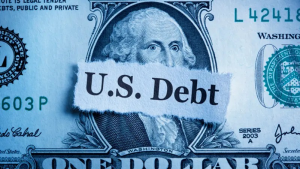The main Wall Street indices look set to start the new week in a consolidatory mood after the previous week's strong gains, as investors await the release of the minutes from the last Federal Reserve meeting as well as the widely-anticipated Jackson Hole symposium. The four-day Democratic National Convention also starts this week.
1. Jackson Hole meeting in focus The week’s key event will be the Federal Reserve’s annual economic symposium in Jackson Hole, Wyoming, starting on Friday, with investors seeking more clues about the pace and timing of rate cuts over the coming months.
Markets just recorded their best week of the year, on expectations of a very soft landing for the U.S. economy, as recent positive data relieved worries over the prospect of a recession.
Most market participants believe the Fed will cut rates at its upcoming September meeting, with the main debate being over the size of the cut - a quarter percentage point or a half point.
Fed chief Jerome Powell’s speech will be the highlight of the gathering, and markets are clearly priced for a dovish outlook, especially after Fed members Mary Daly and Austan Goolsbee flagged the possibility of easing in September over the weekend.
The Fed has maintained its benchmark overnight interest rate in the current 5.25%-5.50% range since last July, after hiking its policy rate by 525 basis points since 2022.
2. Futures consolidate after winning week U.S. stock futures traded with small losses Monday, consolidating after the previous week’s strong gains amid growing optimism over the underlying strength of the world’s largest economy.
By 04:05 ET (08:05 GMT), the Dow futures contract was 10 points, or 0.1%, lower, S&P 500 futures dropped 3 points, or 0.1%, and Nasdaq 100 futures fell by 28 points, or 0.2%.
Goldman Sachs economists have revised their 12-month U.S. recession probability down from 25% to 20%, citing recent economic data that shows no signs of a downturn.
Following the July jobs report that triggered the “Sahm rule,” the Wall Street giant raised its recession estimates from 15% to 25%.
The increase was positioned midway between the long-term average recession probability of 15%—based on the historical occurrence of a recession every seven years—and the 35% estimate during the bank turmoil in early 2023.
However, recent economic indicators have prompted a reassessment.
Specifically, the nonmanufacturing ISM index for July rebounded, with its employment component entering expansion territory for the first time since November 2023, economists noted.
Moreover, retail sales for July beat expectations, suggesting strong real consumption growth. Also, initial jobless claims have declined over the past two weeks, aligning with the idea that the previous increase was partly due to weather and residual seasonality effects. The Financial Conditions Index (FCI) has also eased since the payroll report.
"When recession strikes, it usually strikes quickly,” economists explained.
“This means that the reassuring news on economic activity, layoffs, and financial conditions deserves some weight in assessing whether the July jobs report was an indication that recession is starting or just one weak print."
They further observe that if the U.S. continues on its current growth trajectory, it could start to resemble other G10 economies where the Sahm rule has been less predictive, holding true in less than 70% of cases. Several smaller economies, such as Canada, Sweden, Norway, and New Zealand, have seen significant unemployment increases without slipping into recession.
Looking ahead, Goldman Sachs economists indicate that if the August jobs report, set to be released on September 6, shows positive signs, they may lower their recession probability back to 15%.
On the monetary policy front, economists are more confident in their forecast of a 25-basis-point rate cut at the September 17-18 FOMC meeting. However, they do not rule out the possibility of a 50-basis-point cut if the jobs report disappoints again, given that "with inflation very benign and the labor market fully rebalanced, it has become increasingly obvious that a 5.25%-5.5% policy rate—now the highest across the G10—is excessive."
Still, the economists point out that the current level of the federal funds rate is less significant for financial conditions than the medium-term path priced into financial markets. They suggest that the Federal Reserve could achieve similar accommodation by signaling a series of smaller 25-basis-point cuts as by delivering a larger 50-basis-point cut.













